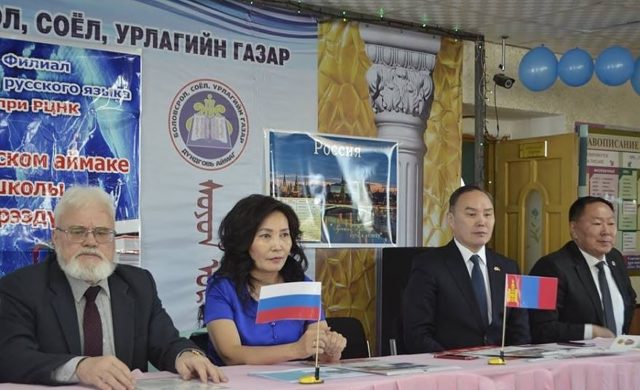
Mongolia Rapidly Moving Out of Russian World, Raising Concerns in Moscow
Publication: Eurasia Daily Monitor Volume: 16 Issue: 90
By:

For most of the Soviet period after 1945, Russians informally viewed Mongolia as “the 16th Soviet republic” not only because it tried to become one during World War II, but also because, even more than Bulgaria, it slavishly copied Soviet laws and practices. Notably, Mongolia introduced a Cyrillic-based alphabet close to Russian in 1941 (Asiarussia.ru, April 1, 2018). Moreover, it promoted Russian in its media and educational system to the point that, in many sectors, Russian displaced Mongol as the most frequently used language (Cod15.ru, May, 10 2018).
This pattern partially had its roots in the fact that Imperial Russia played a key role in Mongolia’s acquisition of independence from China just over a century ago. But additionally, it stems from the history of the Soviet Union using this large (one-third the size of the United States) but underpopulated (just over three million residents now) Northeast Asian country to put pressure on China, which still controls Inner Mongolia. Moscow further sought to use its dominance in Mongolia to prevent Beijing from using the Mongols against their co-ethnics inside Soviet Russian borders, the Buryats (or Buryat Mongols as they were known until 1958) (Fergananews.com, September 11, 2008). However, with the collapse of the Soviet empire in 1989 and then of the Soviet Union itself two years later, all that began to change. And now, in the words of one Russian specialist, “an entire generation has grown up in Mongolia that does not know Russian” (Rossyiskaya Gazeta, June 11, 2019). Indeed, some in Mongolia even want to do away with the Cyrillic alphabet entirely and go back to the vertical script Mongols had used for centuries (Vb.kg, May 11, 2017; Gtrkchita.ru, April 17, 2018; 161.ru, May 16, 2019).
From Moscow’s perspective, such moves on language and alphabets in Mongolia are just as offensive and dangerous as similar policies in the former Soviet republics (see EDM, January 28, 2019; Commentaries, March 5, 2018). Indeed, they may be even more worrisome for two reasons. On the one hand, they introduce a new complexity to Russia’s relations with China, further undermining Moscow’s confidence that it can reliably expect Ulaanbaatar to be on its side in talks with Beijing. And on the other, changes in Mongolia in this regard are likely to have an impact on the already-restive Buryats within current Russian borders, who, to this day, follow closely what happens in Mongolia (Gazeta-n1.ru, March 17, 2017).
While Russian does remain the most widely known foreign language in Mongolia—Chinese has so far not made massive inroads as many had predicted—it is now very much a foreign language rather than a national one. It has not been a requirement for entry into Mongolian universities since 1990, and it has not been a compulsory subject in primary and secondary schools since 2003, the year in which English replaced Russia as the required foreign language. What this means—and what anecdotal evidence appears to confirm (Quora.com, October 18, 2014)—is that while most Mongols over 35 know Russian, most below that age no longer do. This pattern suggests the role of Russian will continue to decline unless radical measures are taken, something Moscow would like to see but which Ulaanbaatar presently has no plans to introduce.
Just how dire the situation of the Russian language and, with it, of Russian cultural and political influence in Mongolia has become was recently described by Nyamzhav Naymdavaa, a Russian-language teacher in the Mongolian capital. In a paper for delivery at a Moscow competition on Russian-language use outside the Russian Federation, she recalls “the golden times of the end of the 1940s, when Russian was studied in all the schools of the country four or five hours a week, or the end of the 1970s, when a Pedagogical Institute of the Russian Language was established, an institution that, over the decade of its existence, graduated 1,847 Russian teachers.” Those times, she says, are not likely to reappear. Worse, Naymdavaa argues, in 1989, Ulaanbaatar canceled the contracts of all Russians teaching Russian in Mongolia. As a result, 500 lost their jobs altogether, and “more than 200” stopped providing Russian-language classes and began to teach English instead (Rossyiskaya Gazeta, June 11, 2019).
To be sure, the Ulaanbaatar-based teacher writes, Russian instruction did not completely disappear. But even positive steps contain negative aspects. Three years ago, for example, the Mongolian Ministry of Education said schools could reintroduce Russian-language courses but only where each could assemble “no less than 25” pupils who wanted to study the language. In some places, that has effectively blocked Russian instruction altogether. And she said she was encouraged that Ulaanbaatar has restored a Russian-language television program after canceling it 33 years ago.
Moscow has responded to this situation by increasing the number of scholarships for Mongols who want to study Russian in Russian universities, by providing more support to Russian-language instructors in Mongolia so that they can help the approximately 3,000 young people there in such classes continue, and by launching a major propaganda campaign against any further cuts in Russian-language instruction or any consideration of the idea that Mongolia should dispense with the Cyrillic alphabet and go back to its original national one (Russkiymir.ru, June 3, 2019; Vb.kg, May 11 2017; Gtrkchita.ru, April 17, 2018).
Moscow may be on the winning side of efforts to block a return to the pre-Cyrillic national script, as there are many Mongols who oppose such a move; but it almost certainly will be the loser elsewhere. All evidence seems to suggest that the Russian language will continue to decline in importance in Mongolia. And with that decline, Russian influence will wane there as well.



